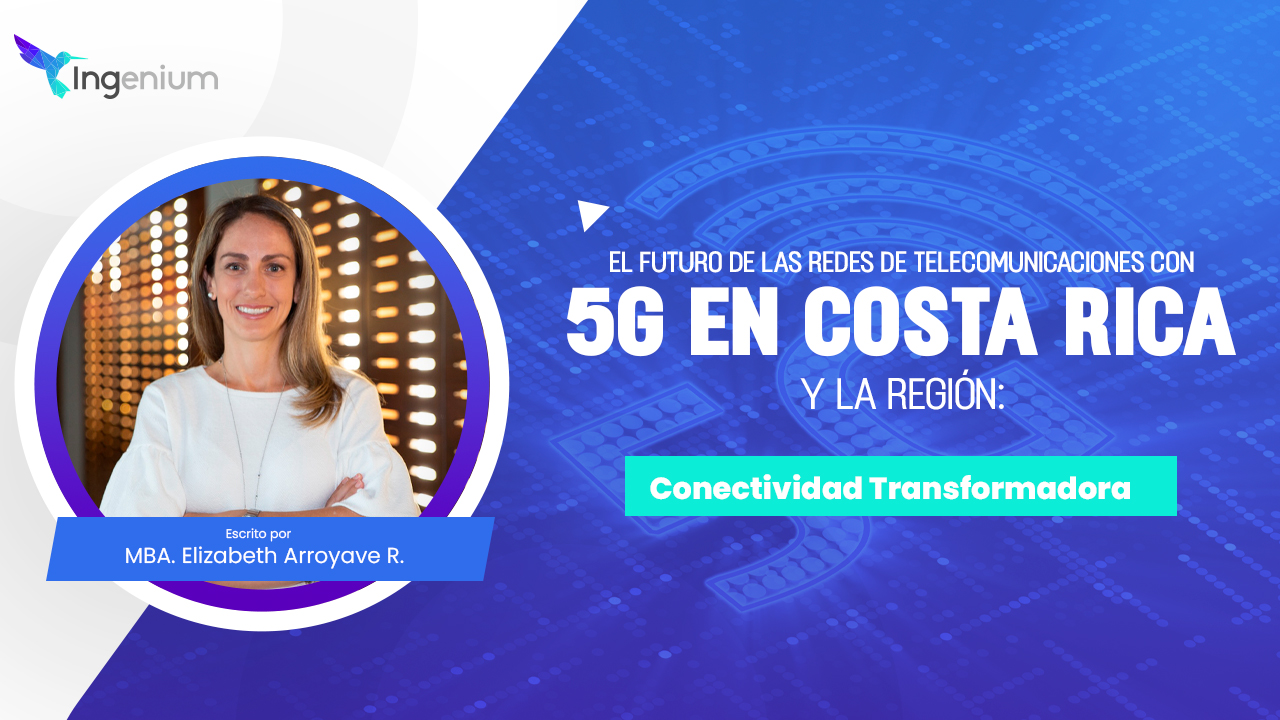By MBA. Elizabeth Arroyave R. - España | VP Chamber of Information Technologies of Costa Rica Costa Rica
Costa Rica, known for its stunning biodiversity and natural beauty, is embarking on a new technological era that promises to transform the way we connect and interact. In this article, we will review the future of 5G networks in Latin America and how it is being introduced into fields such as business training and complex data visualization, marking a significant milestone in technological development, offering not only faster connection speeds, but also revolutionary possibilities for various sectors.
Unmatched speed and efficiency
5G, or fifth-generation mobile network technology, far outperforms its predecessor, 4G. Connection speed is one of the highlights, as 5G can provide significantly faster download and upload speeds. This translates into a smoother and faster user experience, ideal for data-intensive applications, high-quality video conferencing, and seamless online gaming.
Industry Transformation: Implications for Economic Development
The deployment of 5G technology in Costa Rica and the region will not only benefit end consumers, but will also have a significant impact on the economy. Key sectors such as health, education and industry are expected to undergo a radical transformation.
-
Connected Health:
Telemedicine will benefit greatly from the low latency and high speed of 5G. Healthcare professionals will be able to conduct virtual consultations, share medical data in real-time, and access critical information more efficiently, improving patient care.
-
Digital Education:
Distance education will become more accessible and effective thanks to 5G. Students of all ages will be able to access educational content online, participate in virtual classes with higher quality, and collaborate on projects more efficiently.
-
Industry 4.0:
The implementation of technologies such as the Internet of Things (IoT) will accelerate with 5G. Factories and companies will be able to optimize their processes, monitor production in real-time, and improve operational efficiency.
Innovation in Emerging Sectors
5G paves the way for innovation in emerging sectors, such as augmented reality (AR) and virtual reality (VR), that go beyond entertainment. In addition, the future of 5G networks in Latin America is crude for fields such as business training and complex data visualization.
The implementation of smart cities will also be boosted, with sensors and connected devices that will allow for more efficient management of resources, greater security and a better quality of life for inhabitants.
Challenges and Considerations
Despite the exciting prospects offered by 5G, there are also challenges to consider. Cybersecurity and data privacy are critical concerns that need to be proactively addressed to ensure a smooth transition into this new technological era.
In addition, it is essential to address digital access gaps to ensure that all citizens have the opportunity to benefit from new connectivity capabilities. This involves a joint effort between government, business and civil society.
The future of telecommunications networks with 5G is exciting and promises significant transformations in the way we live, work, and connect. From improvements in healthcare to advancements in education and industry, 5G is set to play a key role in sustainable development and prosperity for years to come. With careful implementation and ongoing collaboration, Costa Rica is poised to embrace a connected and vibrant future.
5G in Latin America and the challenges for the data center sector
Since mobile telephony appeared in the late 70's and early 80's we observed an increasingly rapid advance of telecommunications. Since then, we've witnessed how we went from making simple phone calls to sending multimedia files and even banking from a smartphone; and with the arrival of 5G and its adoption in Latin America, its benefits and the challenges to adopt this technology become evident.
The future of 5G networks in Latin America promises that the Internet of Things (IoT) will be the big winner with the adoption of the 5G network, according to Statista, it is expected that by the end of 2025 there will be approximately 1.2 billion IoT connections in Latin America, and will supply close to one billion IoT devices available in the region.
The delayed reality of 5G adoption in Latin America is evident with respect to countries such as the United States or South Korea. Argentina, Brazil, Chile, Guatemala, Mexico, Puerto Rico, Peru, the Dominican Republic, and Uruguay are the countries in the region that lead the way in the implementation of these networks. It is expected that by 2025, around 14% of mobile network accesses will be through the 5G technology.
"Governments must regulate, and demand from operators, 5G coverage by providing the appropriate legal frameworks so that the enormous investment that operators must make has the maximum institutional guarantees.
According to Statista, the six largest economies in Latin America – Brazil, Mexico, Argentina, Colombia, Chile and Peru – would need to invest a total of 120,000 million dollars for 5G technology to be deployed throughout their territory with a uniform speed of 50 Mbps; This makes evident the need for a more expeditious regulation that provides the necessary guarantees so that all those involved obtain the expected profitability," said Fernando García, CSO of Ingenium.
The main challenge for data center developers is to prepare for the massive amount of data, and to be able to build enough data centers to store and process all this information that continues to grow exponentially. First it will be the big cities, then the smaller cities and finally rural areas that are going to need Edge or proximity data centers to store and process all the data.
The powerful capability of edge computing promises to handle massive amounts of data close to its source, which would prevent large amounts of information from having to be transmitted or sent to the cloud or centralized data centers for processing. That proximity, coupled with the 5G digital infrastructure, will allow more efficient, fast and stable processes in the network, which will bring a series of benefits such as autonomy and near real-time decision-making for different industries.
About this article
This article was produced through a partnership between Ingenium and thought leaders in different disciplines. This time we have the support of MBA. Elizabeth Arroyave, VP of the Chamber of Information Technologies of Costa Rica (CAMTIC). In addition, he has extensive experience in the opening of 5G in Costa Rica. Our goal is to bring valuable content to readers and contribute to the Data Center industry from our knowledge and track record in the market.



